Steven Hoi
CompeteSMoE -- Effective Training of Sparse Mixture of Experts via Competition
Feb 04, 2024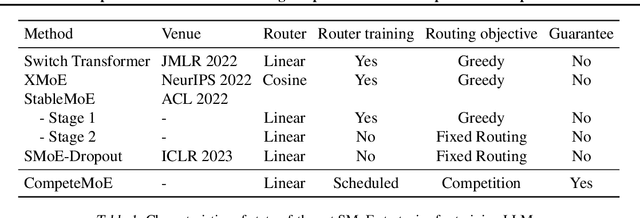

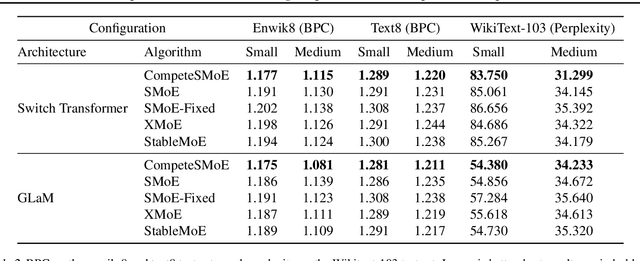
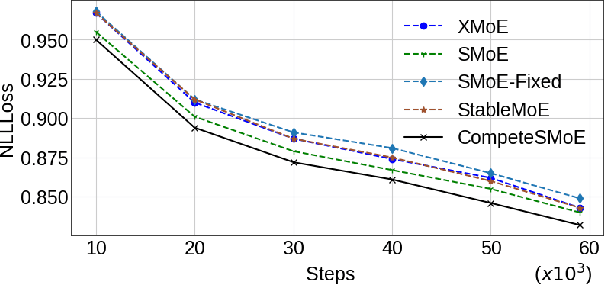
Abstract:Sparse mixture of experts (SMoE) offers an appealing solution to scale up the model complexity beyond the mean of increasing the network's depth or width. However, effective training of SMoE has proven to be challenging due to the representation collapse issue, which causes parameter redundancy and limited representation potentials. In this work, we propose a competition mechanism to address this fundamental challenge of representation collapse. By routing inputs only to experts with the highest neural response, we show that, under mild assumptions, competition enjoys the same convergence rate as the optimal estimator. We further propose CompeteSMoE, an effective and efficient algorithm to train large language models by deploying a simple router that predicts the competition outcomes. Consequently, CompeteSMoE enjoys strong performance gains from the competition routing policy while having low computation overheads. Our extensive empirical evaluations on two transformer architectures and a wide range of tasks demonstrate the efficacy, robustness, and scalability of CompeteSMoE compared to state-of-the-art SMoE strategies.
HyperRouter: Towards Efficient Training and Inference of Sparse Mixture of Experts
Dec 12, 2023Abstract:By routing input tokens to only a few split experts, Sparse Mixture-of-Experts has enabled efficient training of large language models. Recent findings suggest that fixing the routers can achieve competitive performance by alleviating the collapsing problem, where all experts eventually learn similar representations. However, this strategy has two key limitations: (i) the policy derived from random routers might be sub-optimal, and (ii) it requires extensive resources during training and evaluation, leading to limited efficiency gains. This work introduces \HyperRout, which dynamically generates the router's parameters through a fixed hypernetwork and trainable embeddings to achieve a balance between training the routers and freezing them to learn an improved routing policy. Extensive experiments across a wide range of tasks demonstrate the superior performance and efficiency gains of \HyperRouter compared to existing routing methods. Our implementation is publicly available at {\url{{https://github.com/giangdip2410/HyperRouter}}}.
Personalised Distillation: Empowering Open-Sourced LLMs with Adaptive Learning for Code Generation
Oct 28, 2023



Abstract:With the rise of powerful closed-sourced LLMs (ChatGPT, GPT-4), there are increasing interests in distilling the capabilies of close-sourced LLMs to smaller open-sourced LLMs. Previous distillation methods usually prompt ChatGPT to generate a set of instructions and answers, for the student model to learn. However, such standard distillation approach neglects the merits and conditions of the student model. Inspired by modern teaching principles, we design a personalised distillation process, in which the student attempts to solve a task first, then the teacher provides an adaptive refinement for the student to improve. Instead of feeding the student with teacher's prior, personalised distillation enables personalised learning for the student model, as it only learns on examples it makes mistakes upon and learns to improve its own solution. On code generation, personalised distillation consistently outperforms standard distillation with only one third of the data. With only 2.5-3K personalised examples that incur a data-collection cost of 4-6$, we boost CodeGen-mono-16B by 7% to achieve 36.4% pass@1 and StarCoder by 12.2% to achieve 45.8% pass@1 on HumanEval.
InstructBLIP: Towards General-purpose Vision-Language Models with Instruction Tuning
May 11, 2023Abstract:General-purpose language models that can solve various language-domain tasks have emerged driven by the pre-training and instruction-tuning pipeline. However, building general-purpose vision-language models is challenging due to the increased task discrepancy introduced by the additional visual input. Although vision-language pre-training has been widely studied, vision-language instruction tuning remains relatively less explored. In this paper, we conduct a systematic and comprehensive study on vision-language instruction tuning based on the pre-trained BLIP-2 models. We gather a wide variety of 26 publicly available datasets, transform them into instruction tuning format and categorize them into two clusters for held-in instruction tuning and held-out zero-shot evaluation. Additionally, we introduce instruction-aware visual feature extraction, a crucial method that enables the model to extract informative features tailored to the given instruction. The resulting InstructBLIP models achieve state-of-the-art zero-shot performance across all 13 held-out datasets, substantially outperforming BLIP-2 and the larger Flamingo. Our models also lead to state-of-the-art performance when finetuned on individual downstream tasks (e.g., 90.7% accuracy on ScienceQA IMG). Furthermore, we qualitatively demonstrate the advantages of InstructBLIP over concurrent multimodal models. All InstructBLIP models have been open-sourced at https://github.com/salesforce/LAVIS/tree/main/projects/instructblip.
LogAI: A Library for Log Analytics and Intelligence
Jan 31, 2023Abstract:Software and System logs record runtime information about processes executing within a system. These logs have become the most critical and ubiquitous forms of observability data that help developers understand system behavior, monitor system health and resolve issues. However, the volume of logs generated can be humongous (of the order of petabytes per day) especially for complex distributed systems, such as cloud, search engine, social media, etc. This has propelled a lot of research on developing AI-based log based analytics and intelligence solutions that can process huge volume of raw logs and generate insights. In order to enable users to perform multiple types of AI-based log analysis tasks in a uniform manner, we introduce LogAI (https://github.com/salesforce/logai), a one-stop open source library for log analytics and intelligence. LogAI supports tasks such as log summarization, log clustering and log anomaly detection. It adopts the OpenTelemetry data model, to enable compatibility with different log management platforms. LogAI provides a unified model interface and provides popular time-series, statistical learning and deep learning models. Alongside this, LogAI also provides an out-of-the-box GUI for users to conduct interactive analysis. With LogAI, we can also easily benchmark popular deep learning algorithms for log anomaly detection without putting in redundant effort to process the logs. We have opensourced LogAI to cater to a wide range of applications benefiting both academic research and industrial prototyping.
BLIP-2: Bootstrapping Language-Image Pre-training with Frozen Image Encoders and Large Language Models
Jan 30, 2023Abstract:The cost of vision-and-language pre-training has become increasingly prohibitive due to end-to-end training of large-scale models. This paper proposes BLIP-2, a generic and efficient pre-training strategy that bootstraps vision-language pre-training from off-the-shelf frozen pre-trained image encoders and frozen large language models. BLIP-2 bridges the modality gap with a lightweight Querying Transformer, which is pre-trained in two stages. The first stage bootstraps vision-language representation learning from a frozen image encoder. The second stage bootstraps vision-to-language generative learning from a frozen language model. BLIP-2 achieves state-of-the-art performance on various vision-language tasks, despite having significantly fewer trainable parameters than existing methods. For example, our model outperforms Flamingo80B by 8.7% on zero-shot VQAv2 with 54x fewer trainable parameters. We also demonstrate the model's emerging capabilities of zero-shot image-to-text generation that can follow natural language instructions.
Detect-Localize-Repair: A Unified Framework for Learning to Debug with CodeT5
Dec 22, 2022



Abstract:Automated software debugging is a crucial task for improving the productivity of software developers. Many neural-based techniques have been proven effective for debugging-related tasks such as bug localization and program repair (or bug fixing). However, these techniques often focus only on either one of them or approach them in a stage-wise manner, ignoring the mutual benefits between them. In this work, we propose a novel unified \emph{Detect-Localize-Repair} framework based on a pretrained programming language model CodeT5 to seamlessly address these tasks, named CodeT5-DLR. Specifically, we propose three objectives to adapt the generic CodeT5 for debugging: a bug detection objective to determine whether a given code snippet is buggy or not, a bug localization objective to identify the buggy lines, and a program repair objective to translate the buggy code to its fixed version. We evaluate it on each of these tasks and their combined setting on two newly collected line-level debugging datasets in Java and Python. Extensive results show that our model significantly outperforms existing baselines from both NLP and software engineering domains.
BotSIM: An End-to-End Bot Simulation Toolkit for Commercial Task-Oriented Dialog Systems
Nov 30, 2022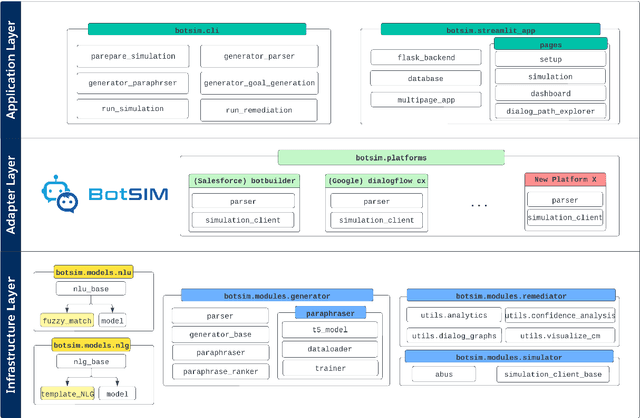

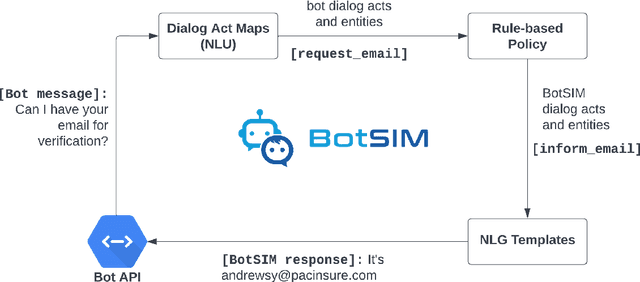

Abstract:We introduce BotSIM, a modular, open-source Bot SIMulation environment with dialog generation, user simulation and conversation analytics capabilities. BotSIM aims to serve as a one-stop solution for large-scale data-efficient end-to-end evaluation, diagnosis and remediation of commercial task-oriented dialog (TOD) systems to significantly accelerate commercial bot development and evaluation, reduce cost and time-to-market. BotSIM adopts a layered design comprising the infrastructure layer, the adaptor layer and the application layer. The infrastructure layer hosts key models and components to support BotSIM's major functionalities via a streamlined "generation-simulation-remediation" pipeline. The adaptor layer is used to extend BotSIM to accommodate new bot platforms. The application layer provides a suite of command line tools and a Web App to significantly lower the entry barrier for BotSIM users such as bot admins or practitioners. In this report, we focus on the technical designs of various system components. A detailed case study using Einstein BotBuilder is also presented to show how to apply BotSIM pipeline for bot evaluation and remediation. The detailed system descriptions can be found in our system demo paper. The toolkit is available at: https://github.com/salesforce/BotSIM .
BotSIM: An End-to-End Bot Simulation Framework for Commercial Task-Oriented Dialog Systems
Nov 30, 2022Abstract:We present BotSIM, a data-efficient end-to-end Bot SIMulation toolkit for commercial text-based task-oriented dialog (TOD) systems. BotSIM consists of three major components: 1) a Generator that can infer semantic-level dialog acts and entities from bot definitions and generate user queries via model-based paraphrasing; 2) an agenda-based dialog user Simulator (ABUS) to simulate conversations with the dialog agents; 3) a Remediator to analyze the simulated conversations, visualize the bot health reports and provide actionable remediation suggestions for bot troubleshooting and improvement. We demonstrate BotSIM's effectiveness in end-to-end evaluation, remediation and multi-intent dialog generation via case studies on two commercial bot platforms. BotSIM's "generation-simulation-remediation" paradigm accelerates the end-to-end bot evaluation and iteration process by: 1) reducing manual test cases creation efforts; 2) enabling a holistic gauge of the bot in terms of NLU and end-to-end performance via extensive dialog simulation; 3) improving the bot troubleshooting process with actionable suggestions. A demo of our system can be found at https://tinyurl.com/mryu74cd and a demo video at https://youtu.be/qLi5iSoly30. We have open-sourced the toolkit at https://github.com/salesforce/botsim
DeepTIMe: Deep Time-Index Meta-Learning for Non-Stationary Time-Series Forecasting
Jul 14, 2022



Abstract:Deep learning has been actively applied to time-series forecasting, leading to a deluge of new autoregressive model architectures. Yet, despite the attractive properties of time-index based models, such as being a continuous signal function over time leading to smooth representations, little attention has been given to them. Indeed, while naive deep time-index based models are far more expressive than the manually predefined function representations of classical time-index based models, they are inadequate for forecasting due to the lack of inductive biases, and the non-stationarity of time-series. In this paper, we propose DeepTIMe, a deep time-index based model trained via a meta-learning formulation which overcomes these limitations, yielding an efficient and accurate forecasting model. Extensive experiments on real world datasets demonstrate that our approach achieves competitive results with state-of-the-art methods, and is highly efficient. Code is available at https://github.com/salesforce/DeepTIMe.
 Add to Chrome
Add to Chrome Add to Firefox
Add to Firefox Add to Edge
Add to Edge